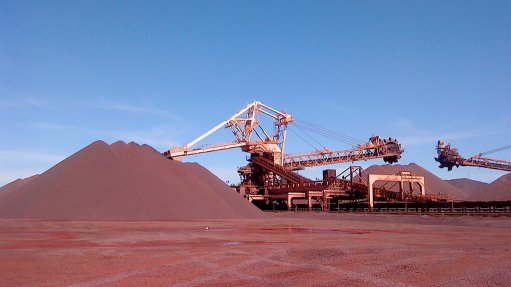
HARD TO PORT Ore ready for export at the Saldanha Port
Macroeconomic researcher Fitch Solutions – formerly known as BMi Research – has maintained its average iron-ore price forecast for 2018 at $6.0/t.
However, despite the recent August rally – which stemmed from a combination of stocking up of ore by Chinese steel producers as low-grade polluting mines were shut down by authorities and the increasing margins of steel producers on the back of the government’s capacity replacement drive that buoyed production – it is expected that prices will decline in subsequent months and years as Chinese economic growth refocuses away from heavy industry to services, dampening demand for iron-ore.
While this overall long-term downward trend will be apparent, Fitch expects significant volatility in the market as China’s economic and environmental policy reforms will continue and create from time to time temporary supply tightness and uncertainty among market participants.
Fitch maintains its view that iron-ore prices will follow an overall downtrend in the coming quarters. As speculative buying on expectations of poor future iron-ore supply dies down, and falling steel prices on the back of slowing global steel demand lower margins and in turn steel production, prices will resume their downward track. The shifting of Chinese economic growth away from heavy industries towards services will slow demand for industrial metals including steel going forward.
“Recent high frequency indicators show Chinese steel production growth averaged 6.5% year-on-year in the first seven months of 2018, compared with 5.4% in 2017. “We expect this growth to slow down in the coming months as shipments are being delayed as a result of tight checks on exports by authorities in a bid to halt the smuggling of scrap steel to South-East Asia and monitor the legitimacy of tax rebate applications on value-added steel,” says Fitch Solutions senior manager Peter Hoflich.
He adds that as per Fitch’s long-held view, Chinese iron-ore imports already contracted by 0.6% year-on-year in the first seven months of 2018, compared with a growth of 5.1% over 2017. Iron-ore inventories at Chinese ports remain near record highs at 154-million tons as of August 2018, suggesting a well-supplied market.
Fitch maintains its consensus view over 2018 and in the longer term as it expects prices to drop from an average of $54/t in 2019 to $48/t in 2022, underpinned by its less positive outlook for Chinese growth than previous years. Slowing economic growth in the country will cause the waning of domestic steel demand, eventually leading to an oversupply of steel on the global market, pushing prices downwards. Iron-ore import demand will consequently decline in the coming years as steel production growth will taper, owing to lower prices from over supply.
This will be driven by the reining in of China’s fiscal spending from 2018 onwards, which will have a direct impact on construction-based fixed-asset investment, the growth of which is instrumental in driving global ferrous metals demand.
“Furthermore, on the supply-side of iron-ore, consistent and large margins of major global producers, including those in Australia and Brazil with cash costs of below $20/t, will incentivise additional output and mining projects, leading to further weakening of iron-ore prices over the next five years. “While this overall long-term downward trend will be apparent, we expect significant volatility in the market as China’s economic and environmental policy reforms will continue and create, from time to time, temporary supply tightness and uncertainty among market participants.
“Globally, India will experience iron-ore demand growth as steel production continues to accelerate. Meanwhile, US and South Korean demand growth will remain subdued, owing to a stagnation of steel production growth in the respective countries.”